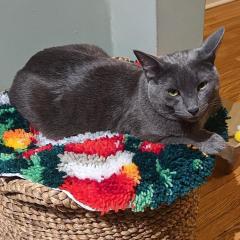-
Posts
5,134 -
Joined
-
Last visited
-
Yes, two squeezes. Give it the first squeeze to make it half full, then turn the mouth side up, and release air by squeezing it again with your thumb and index finger, turn it down while keep squeezing it, and release your thumb and index finger to make it full.
-
I think that omyotsuke is a variant of the word omiotsuke, spelled おみおつけ, 御味御付, 御御御汁, etc. My Tokyo-born mother, who is now in her 70s, still calls miso soup omiotsuke, while I have switched to the more common word miso shiru or o-miso shiru. I can't tell any difference between omiotsuke and (o-)miso shiru, but some people say that the former is a soup of substantial ingredients. They say that a miso soup with only a few cubes of tofu, a few slices of negi, and so on cannot be called omiotsuke.
-
melonpan: I wonder if you can get dishwasher-safe chopsticks where you live.
-
I wouldn't recommend making any experiments! I have made silly mistakes several times before, making dark spots on the gold rim.
-
Can you post a photo of your sets? I wonder what the label says. If you see characters like 電子レンジ使用可 and 電子レンジ対応 then, you can put them in the microwave.
-
A summary of the long reply from the factory: Alloy ingredients: Carbon, chromium, molybdenum, vanadium, cobalt, etc. Hardness: Approx. 63
-
Sorry, no reply from Tsubaya up to now. Got a reply from them just now. It says that they checked with Kappabashi Tsubaya, which said that they would send an inquiry to the factory (plant?, workshop?), so that a reply would be sent next week.
-
Sorry, no reply from Tsubaya up to now.
-
Do you want to know the hardness of your powder HSS Damascus blade? And, the exact composition of the steel? If you post any specific questions you want to ask, I can send the shop another inquiry.
-
A few thoughts about Momofuku Ko: Momofuku can't mean lucky peach. It means peach luck. Momo = Peach Fuku = Luck To mean lucky peach, it has to be changed to fukumomo. cf. Fuku mochi = Lucky rice cake Note that Momofuku in Momofuku Ando, who was the inventor of instant ramen, means one hundred lucks. Momo = One hundred Ko means child(ren) in Japanese, not "son of". Thus, kinoko (ki = tree(s) + no = 's + ko = child(ren)) means mushroom. I'm still interested to know more about the onigiri (and the pickle) given as a gift. Is it considered by Momofuku Ko as an extension of the lunch? Or, is it just a product of the whim of the chefs? What are the ingredients? What rice variety? Is the flavor always the same?
-
I have one Global santoku (G-46) (not santuku), which weighs 170 g, and I don't think it's particularly light. As for maintenance, here is general information on the manufacturer's website: http://www.yoshikin.co.jp/w/maintenance/maintenance_01.html
-
Actually, there is one izakaya, probably only one of its kind, in Tokyo, Japan, with a similar concept. You first order drinks, which are offered for every low prices, and then you make your own dishes in the kichen. The name of the izakaya is Seihin (lit. Chastity and Poverty). Customers spend 1,500 to 2,000 yen, including drinks, on average per head, and leave the space with a full stomach (and a happy face). If you want to look inside the izakaya, here are some links: http://nylongirls.jp/topics/2010/06/seihin.html where a pretty girl reports on this amasing izakaya. Another report: Part 1: http://portal.nifty.com/2010/03/31/b/ Part 2: http://portal.nifty.com/2010/03/31/b/2.htm Sorry, they are in Japanese only, and sorry for getting off topic!
-
No words from the staff, and seemingly no expiration date indicated on each onigiri? Now I really wonder about the attitude of the staff and that of the management, who are supposed to train them. I'm almost speechless!
-
I keep wondering about the onigiri. Judging from FDE's description of the onigiri, it sounds like a tori meshi onigiri (chicken rice ball). Images of tori meshi onigiri Note that not all onigiri are wrapped in nori. There are no strict rules, but onigiri made of plain rice are often wrapped in nori, while onigiri made of seasoned rice are often nori-less. Onigiri can go bad fast, especially those made of seasoned rice, depending on how they are kept. So, I wonder if the staff tell you to consume the onigiri within, say, four hours.
-
FDE: I mean just that, and let me say that I didn't mean to offend you in any way and that that post of mine is not directed at you. I wrote it for future diners at Ko. I'd really appreciate it if someone could describe what the onigiri were like!









